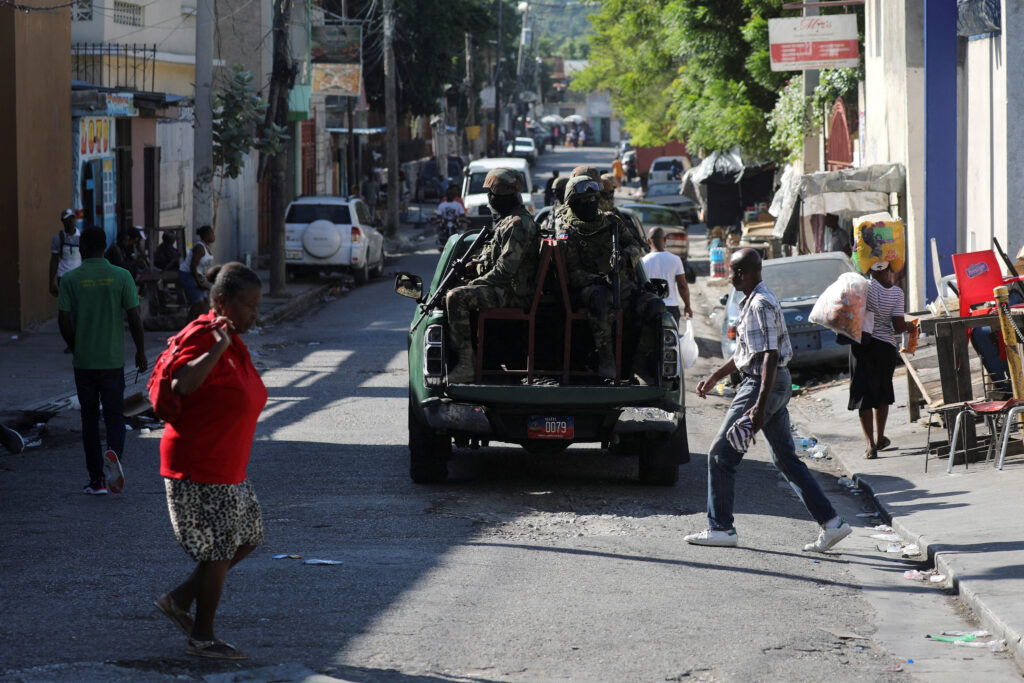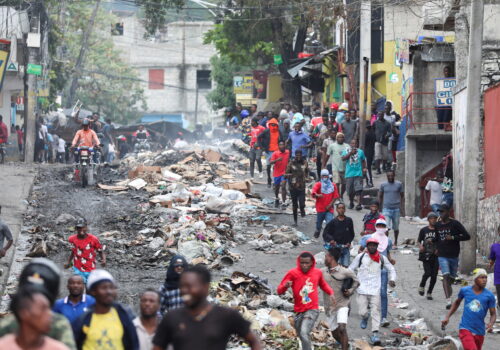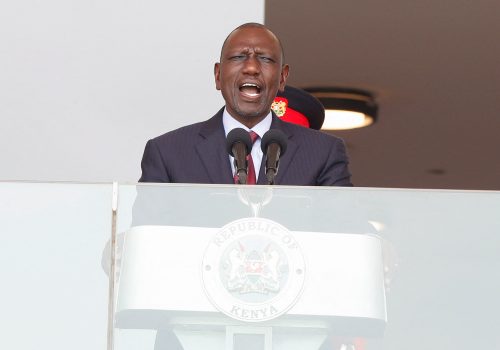On May 2, Secretary of State Marco Rubio designated Haiti’s two most powerful gang coalitions, Viv Ansanm and Gran Grif, as foreign terrorist organizations. This move—along with Rubio’s two trips to the Caribbean earlier this year—signals the Trump administration’s recognition of the growing crisis just 750 miles from Key West, Florida. Still, the imminent collapse of Port-au-Prince may soon demand a broader and more coordinated US response.
This is Haiti’s fourth year without a president, its ninth year without holding presidential elections, and its second year without a single democratically elected official in power. Since the assassination of President Jovenel Moïse in July 2021, the country has witnessed a litany of crises—security, humanitarian, and political—that have internally displaced over one million Haitians, more than half of whom are children. Weakened state institutions and an under-resourced national police force have left Haitians to confront these challenges with little to no support from their government. While resilience has long been a defining trait of the Haitian people, forged through more than two centuries of adversity, the past several months have tested that endurance to its limits. Gangs have made staggering advances into densely populated areas of the capital and previously sheltered rural regions, driving a surge in violence that has claimed over 1,500 lives since January 1.
Experts warn that the total collapse of Port-au-Prince is now closer than ever. What happens if the capital falls to the gangs? Beyond a seismic humanitarian crisis, the Transitional Presidential Council—a provisional governing body formed in April 2024 with the support of the Caribbean Community and the United States—would likely unravel, taking with it any remaining hope for constitutional reform, credible elections, and a functioning central government. And as gangs expand their control beyond urban strongholds and into the countryside, the entire nation would teeter on the edge of state collapse.
While there are no immediate solutions to the crisis in Haiti, there are several tangible steps the United States can take to ameliorate the suffering of the Haitian people and help facilitate the country’s recovery. Failing to do so risks allowing the crisis to not only worsen, but spill over into the United States and throughout the region.
Ripple effects
The paramount consequence of Haiti’s potential collapse into a failed state would be the devastating loss of life and the shattered futures of hundreds of thousands of Haitians. But this fallout would not be contained within the country’s borders—the United States and the broader Caribbean Basin will inevitably feel the ripple effects of the crisis as well.
A humanitarian disaster of this scale would trigger a dramatic surge in migration to countries across the region, including to the US southern border. This coincides with the Trump administration’s revocation of Temporary Protected Status for 200,000 Haitian refugees, forcing deportations at a moment of maximum instability. The Dominican Republic, Haiti’s closest neighbor and a key US ally, would also face intensified pressure—both from refugee flows and the risk of cross-border violence. In the total absence of a functioning state, Haiti could become a staging ground for terrorist activity, drug markets, and transnational criminal networks already active in the region, further destabilizing the Caribbean Basin. With this level of insecurity just miles from the United States’ shores, the situation represents a five-alarm fire for US national security.
US foreign policy in Haiti has long been marked by intervention, mismanagement, and short-term fixes. Many experts fear that the designation of Haiti’s gangs as foreign terrorist organizations falls into the same pattern—failing to address the root causes of gang violence or consider the impact on civilians who rely on aid. And as the failure of the Kenyan Multinational Security Support mission to restore security to Haiti has made clear, even efforts with significant US backing have proved inadequate to the challenges of the moment. Past US interventions and policies toward Haiti have fueled suspicion among many Haitians and hopelessness among many US policymakers. Yet while the US government bears significant responsibility for this skepticism, it also possesses the influence to effect positive—even if incremental—change for Haiti.
How the US can help right now
The US government can take several steps in the near term to bring back a modicum of stability and prepare the nation for “the day after.” Many of the necessary policies already exist—they simply require reauthorization or targeted revisions to be effective.
Although Haiti is widely recognized as the poorest country in the Western Hemisphere, the United States remains the largest market for its most profitable sector: textiles. Thanks to bipartisan legislation passed by Congress in 2006 and 2010, known as the HOPE and HELP acts, which established preferential trade terms for the sector, Haiti’s apparel exports to the United States surged from $231 million in 2001 to $994 million in 2021. Although the crisis has severely undermined textile production, these exports provide a resilient economic lifeline for what remains of Haiti’s formal economy. However, unless reauthorized, these trade preferences are set to expire in September. Rather than imposing tariffs that further destabilize Haiti’s fragile manufacturing sector, Congress should move quickly to preserve the near-shoring of US manufacturing imports by passing HR 1625—the Haiti Economic Lift Program Extension Act of 2025, sponsored by Representative Gregory Murphy (R-NC).
The withdrawal of the US Agency for International Development (USAID) raises many questions about the future of development organizations in Haiti, as hundreds of life-saving programs are put on indefinite hold. Several voices within the Haiti policy community note that the agency’s work, despite its best intentions, sometimes created an overreliance on foreign aid within Haitian institutions. Over a century of this dynamic led Haiti to become, in the words of Haiti expert Jake Johnston, an “aid state.”
In the wake of USAID’s departure, the United States has the opportunity to sculpt a more effective aid strategy that puts the onus of development work in the hands of an ever-resilient Haitian civil society, not just foreign contractors. This strategy proved successful in the implementation of the President’s Emergency Plan for AIDS Relief program. And this approach serves as the foundation of the Global Fragility Act (GFA), a law passed by Congress during US President Donald Trump’s first term that prioritizes localization and reorients US foreign policy strategy in fragile states toward preventing conflict rather than reacting to it. Haiti was designated one of the GFA’s ten priority countries and the Biden administration made meaningful strides toward developing a strategy that prioritizes engagement with a broad range of trusted local partners. Renewing the GFA could build on this groundwork by channeling substantial resources into empowering local partners, thus fostering greater self-reliance within Haitian institutions. Representatives Sarah Jacobs (D-CA) and Michael McCaul (R-TX) have introduced a bill to reauthorize and strengthen the GFA. Yet despite the Trump administration’s support for aid localization, momentum for renewing this policy has faltered in both the legislative and executive branches, leaving its future in peril.
A whole-of-government approach
As Georges Fauriol, an expert on the Caribbean, has described US policy toward Haiti, “the challenge is not so much the absence of a strategy as its disaggregated character.” Whether it be the State Department, the Office of the US Trade Representative, or the Department of Defense’s US Southern Command, the US government possesses no shortage of entities that conduct Haiti policy—not to mention the influence of external interest groups such as those in the US Haitian diaspora.
Although working toward the same mission, these initiatives tend to operate in silos and do not come together to form a cohesive strategy for the long-term stability of the country. This dynamic was evident during the US response to Haiti’s devastating 2010 earthquake, as US Southern Command-led military relief operations and USAID disaster initiatives often struggled with unclear divisions of responsibility, resulting in operational inefficiencies. The GFA and policies such as the Caribbean Basin Security Initiative aim to establish a whole-of-government approach to address this issue. Rather than launching new initiatives for each emerging crisis, the Trump administration should also appoint a special envoy to coordinate and leverage existing Haiti policies within the various branches, helping to shape a more coherent foreign policy for the island and the broader region.
The severity of Haiti’s ongoing crisis makes envisioning “the day after” a challenge. Yet, for countless Haitians, whether living in Haiti or abroad, this vision is worth fighting for, just as it has been during past periods of turmoil. The United States has a strategic interest in advancing a Haiti policy focused on long-term stability rather than short-term fixes. No single policy or initiative will solve the security, humanitarian, and economic challenges that have engulfed Haiti for the past four years. But failing to act at all would further jeopardize the stability of Haiti, the United States, and the region as a whole.
Camilla Reitherman is a young global professional with the Atlantic Council’s Millennium Leadership Program.
Further reading
Mon, Mar 18, 2024
Addressing Haiti’s turmoil starts with its Caribbean neighbors—and US and Canadian support
New Atlanticist By Jason Marczak, Wazim Mowla
A long-term approach is needed in which Caribbean leaders are in the driver’s seat, while Washington and Ottawa help to offset the costs.
Wed, Mar 20, 2024
Gen. Laura Richardson on what an international response to Haiti might look like
New Atlanticist By Katherine Golden
While the United States isn’t currently planning to put boots on the ground in Haiti, SOUTHCOM has a wide range of contingency plans, Richardson said at an AC Front Page event.
Thu, Dec 21, 2023
What Kenya’s proposed mission to Haiti says about Nairobi’s foreign policy
AfricaSource By Sibi Nyaoga
Success in Ruto’s foreign policy approach depends, in part, on the success of this mission to Haiti—one that will be hard to come by.
Image: Members of the Haitian Armed Forces patrol the area as people flee homes following the armed gangs violence over the weekend, many grouped behind an alliance known as Viv Ansanm, at the Poste Marchand suburb, in Port-au-Prince, Haiti December 9, 2024. REUTERS/Ralph Tedy Erol.




